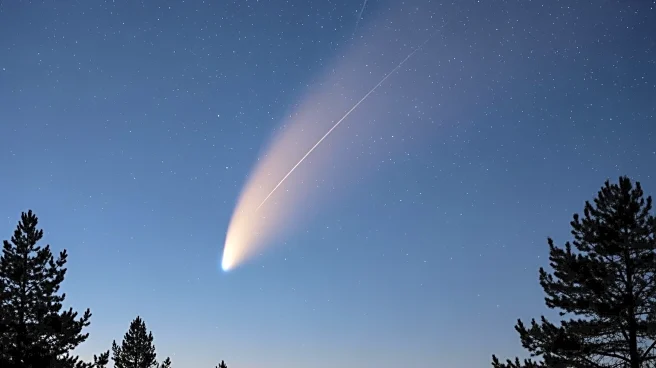What's Happening?
Comet 3I/ATLAS is currently visible in the pre-dawn sky, gaining altitude and brightness as it moves higher before dawn. As of November 20th, the comet was estimated to be at 10th magnitude, slightly brighter than expected. Observers will need a telescope
capable of detecting faint objects to view the comet, which appears as a small, roundish fuzzy object about 30° up in the east-southeast shortly before dawn. The comet displays a green coma and a streaky blue gas tail, typical of solar-system comets. Observers are advised to set up their equipment two hours before sunrise for optimal viewing conditions.
Why It's Important?
The visibility of Comet 3I/ATLAS presents a unique opportunity for astronomers and enthusiasts to observe an interstellar comet, which is a rare occurrence. This event allows for the study of cometary composition and behavior, contributing to our understanding of celestial mechanics and the solar system. The comet's brightness and visibility in the pre-dawn sky make it accessible to amateur astronomers, fostering interest and engagement in astronomy. Additionally, the comet's presence provides a chance to test and refine observational techniques and equipment, enhancing the skills of those involved in astronomical pursuits.
What's Next?
Observers can continue to track Comet 3I/ATLAS as it approaches Eta Virginis, with its visibility expected to improve as it gains altitude. Astronomers may use sky-charting programs to download orbit predictions for new comets, aiding in precise tracking and observation. The comet's trajectory and brightness will be monitored, with potential updates on its visibility and position. Enthusiasts are encouraged to follow expert advice and utilize detailed finder charts to enhance their viewing experience.
Beyond the Headlines
The observation of Comet 3I/ATLAS highlights the importance of amateur astronomy in contributing to scientific knowledge. The event underscores the collaborative nature of astronomical research, where both professional and amateur astronomers share data and insights. This collaboration can lead to discoveries and advancements in understanding interstellar objects and their impact on the solar system. The comet's visibility also serves as a reminder of the dynamic and ever-changing nature of the cosmos, inspiring curiosity and exploration.















